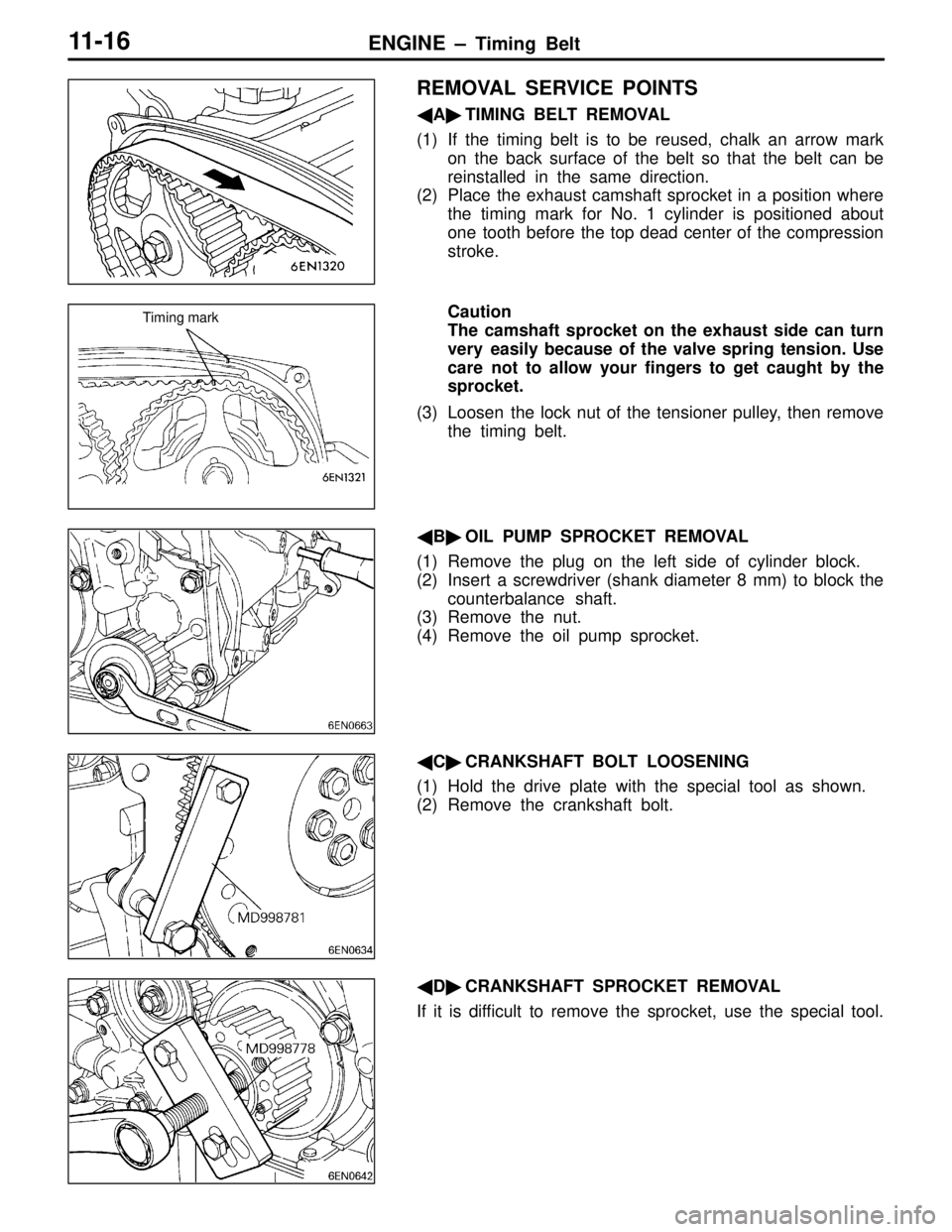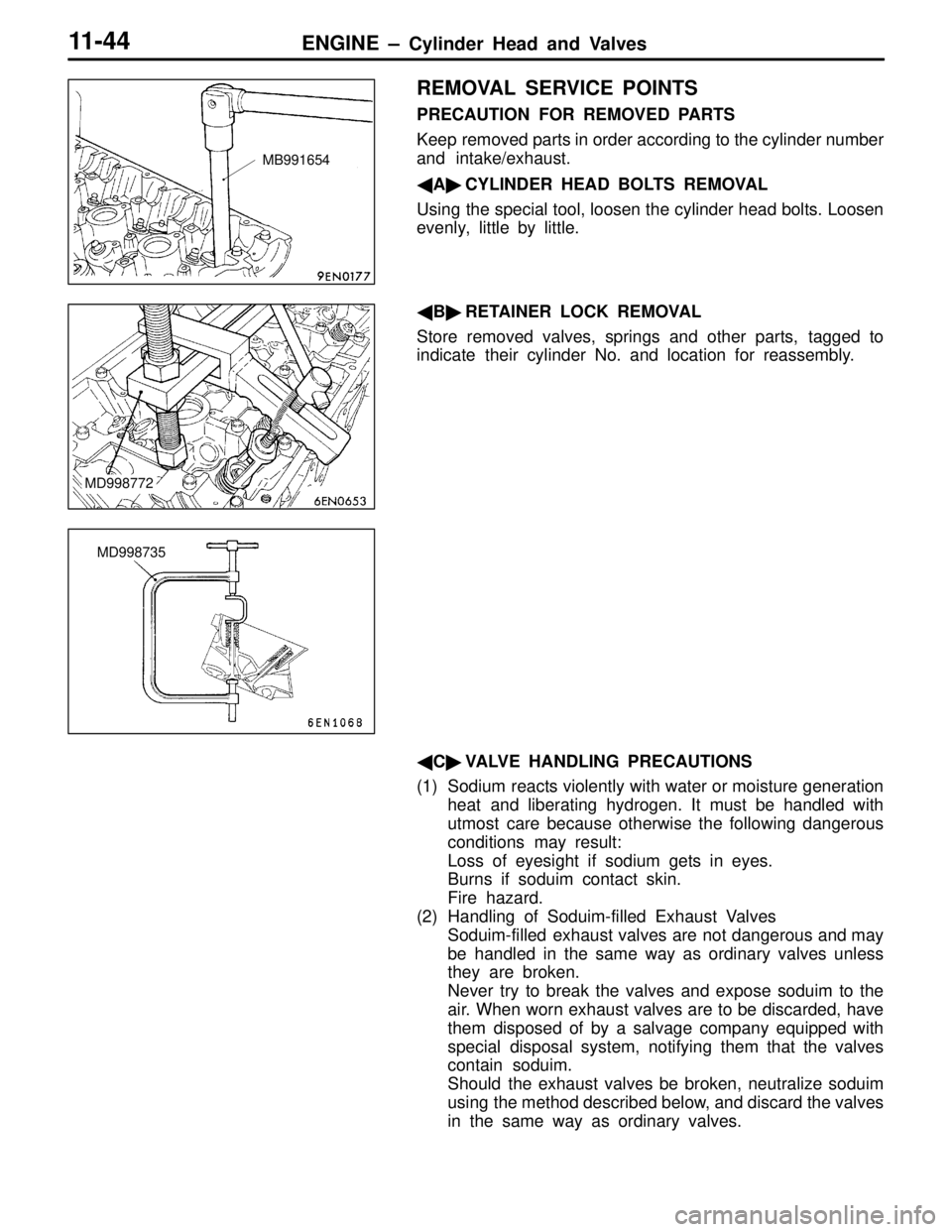Page 41 of 558

ENGINE – Timing Belt11-16
REMOVAL SERVICE POINTS
�A�TIMING BELT REMOVAL
(1) If the timing belt is to be reused, chalk an arrow mark
on the back surface of the belt so that the belt can be
reinstalled in the same direction.
(2) Place the exhaust camshaft sprocket in a position where
the timing mark for No. 1 cylinder is positioned about
one tooth before the top dead center of the compression
stroke.
Caution
The camshaft sprocket on the exhaust side can turn
very easily because of the valve spring tension. Use
care not to allow your fingers to get caught by the
sprocket.
(3) Loosen the lock nut of the tensioner pulley, then remove
the timing belt.
�B�OIL PUMP SPROCKET REMOVAL
(1) Remove the plug on the left side of cylinder block.
(2) Insert a screwdriver (shank diameter 8 mm) to block the
counterbalance shaft.
(3) Remove the nut.
(4) Remove the oil pump sprocket.
�C�CRANKSHAFT BOLT LOOSENING
(1) Hold the drive plate with the special tool as shown.
(2) Remove the crankshaft bolt.
�D�CRANKSHAFT SPROCKET REMOVAL
If it is difficult to remove the sprocket, use the special tool.
Timing mark
Page 42 of 558

ENGINE – Timing BeltENGINE – Timing Belt11-17
�E�TIMING BELT “B” REMOVAL
Make a mark on the back of the timing belt indicating the
direction of rotation so it may be reassembled in the same
direction if it is to be reused.
NOTE
(1) Water or oil on the belt shortens its life drastically, so
the removed timing belt, sprocket, and tensioner must
be free from oil and water. These parts should not be
washed. Replace parts if seriously contaminated.
(2) If there is oil or water on each part check front case
oil seals, camshaft oil seal and water pump for leaks.
�F�COUNTERBALANCE SHAFT SPROCKET
REMOVAL
(1) Set the special tool as shown to prevent the
counterbalance shaft sprocket from turning together.
(2) Loosen the bolt and remove the sprocket.
�G�CRANKSHAFT SPROCKET “B” REMOVAL
If it is difficult to remove the sprocket, use the special tool.
�H�CAMSHAFT SPROCKET BOLT LOOSENING
Use a wrench to hold the hexagonal part of the camshaft,
and then remove the camshaft sprocket mounting bolt.
INSTALLATION SERVICE POINTS
�A�CAMSHAFT SPROCKET BOLT TIGHTENING
Using a wrench, hold the camshaft at its hexagon and tighten
the bolt to the specification.
6EN1322
MD998785
Page 46 of 558

ENGINE – Timing Belt11-21
�I�OIL PUMP SPROCKET INSTALLATION
(1) Insert a Phillips screwdriver (shank diameter 8 mm shaft)
through the plug hole on the left side of the cylinder
block to block the left counterbalance shaft.
(2) Install the oil pump sprocket.
(3) Apply a proper amount of engine oil to the bearing surfaces
of the nuts.
(4) Tighten the nuts to the specified torque.
�J�AUTO TENSIONER INSTALLATION
(1) If the auto tensioner rod is in its fully extended position,
reset it as follows.
(2) Clamp the auto-tensioner in the vise with soft jaws.
(3) Push in the rod little by little with the vise until the set
hole A in the rod is aligned with the hole B in the cylinder.
(4) Insert a wire (1.4 mm in diameter) into the set holes.
(5) Unclamp the auto tensioner from the vise.
(6) Install the auto tensioner to front case and tighten to
the specified torque.
Caution
Leave the wire installed in the auto tensioner.
�K�TENSIONER PULLEY INSTALLATION
Install the tensioner pulley in such direction that its two small
holes are arranged vertically.
6EN0564
A
B
6EN1323
Small holes
Page 50 of 558

ENGINE – Timing Belt11-25
(17)Loosen the retaining bolt of the tensioner pulley.
Caution
Loosening the retaining bolt can cause the intake
and exhaust camshafts to turn, resulting in slackened
timing belt. Use care that the timing belt does not
come off the sprockets at this time.
(18)Pull up the slack of the timing belt by turning the tensioner
in illustrated direction using the special tool and a torque
wrench (0 – 5 Nm).
(19)From this position, turn back the tensioner until the torque
wrench reading becomes 3.5 Nm, then secure it by
tightening the retaining bolt.
(20)Remove the special tool attached in step (16).
(21)Rotate the crankshaft clockwise 2 turns. Then, leave it
intact 15 minutes.
(22)Check to see that the wire inserted when installing the
auto-tensioner can be pulled out lightly. If it can be pulled
out lightly, the timing belt is being tensioned properly.
If so, remove the wire. In addition, check that the rod
protrusion from the auto-tensioner meets the standard
value, which is also an indication of properly tensioned
timing belt.
Standard value: 3.8 – 4.5 mm
(23)If the wire cannot be removed with a light force, repeat
steps (16) through (21) until the proper belt tensioner
is obtained.
INSPECTION
TIMING BELT
Replace belt if any of the following conditions exist.
(1) Hardening of back rubber.
Back side is glossy without resilience and leaves no indent
when pressed with fingernail.
(2) Cracks on rubber back.
(3) Cracks or peeling of canvas.
(4) Cracks on rib root.
(5) Cracks on belt sides.
MD998767
Page 55 of 558
ENGINE – Secondary Air System and Intake Manifold11-30
INSTALLATION SERVICE POINTS
�A�AIR CONTROL VALVE BRACKET INSTALLATION
(1) Attach the air control valve bracket and the engine hanger
to the intake manifold using bolts and nuts with which
the intake manifold is also installed to the engine.
(2) Tighten the bolts and nuts to the specified torque in the
sequence given in the illustration.
�B�AIR PIPE ASSEMBLY INSTALLATION
(1) Install the air pipe assembly to the exhaust manifold and
to the air control valve and secure it provisionally by
tightening the fasteners handtight.
(2) Tighten the fasteners to the specified torque in the
sequence given in the illustration.
(3)
(2) (1)
(3)
(2)(1)(4)
Page 66 of 558

ENGINE – Rocker Arms and Camshaft11-41
(4) Removal the lash adjuster from the container. Then, push
down the steel ball gently and push the plunger to eliminate
diesel fuel from the pressure chamber.
Caution
Make sure the oil hole in the side of the body is pointing
toward container A. Do not point the oil hole at yourself
or other people.
(5) Place the lash adjuster in container B. Then, gently push
down the internal steel ball using wire (0.5 mm in diameter)
or special tool MD998442 and move the plunger through
5 to 10 strokes until it slides smoothly. This operation
will clean the lash adjuster’s pressure chamber.
Caution
The steel ball spring is extremely weak, so the lash
adjuster’s functionality may be lost if the air bleed
wire is pushed in hard.
(6) Remove the lash adjuster from the container. Then, push
down the steel ball gently and push the plunger to eliminate
diesel fuel from the pressure chamber.
Caution
Make sure the oil hole in the side of the body is pointing
toward container A. Do not point the oil hole at yourself
or other people.
(7) Place the lash adjuster in container C. Then, gently push
down the internal steel ball using wire (0.5 mm in diameter)
or special tool MD998442.
Caution
Do not use container C for cleaning. If cleaning is
performed in container C, foreign matter could enter
the pressure chamber when chamber is filled with
diesel fuel.
(8) Stand the lash adjuster with its plunger at the top, then
push the plunger downward firmly until it moves through
its greatest possible stroke. Return the plunger slowly,
then release the steel ball and allow the pressure chamber
to fill with diesel fuel.
MD998442
Diesel fuel
MD998442Diesel fuel
MD998442
Diesel fuel
MD998442
Diesel fuel
MD998442Diesel fuel
Page 69 of 558

ENGINE – Cylinder Head and Valves11-44
REMOVAL SERVICE POINTS
PRECAUTION FOR REMOVED PARTS
Keep removed parts in order according to the cylinder number
and intake/exhaust.
�A�CYLINDER HEAD BOLTS REMOVAL
Using the special tool, loosen the cylinder head bolts. Loosen
evenly, little by little.
�B�RETAINER LOCK REMOVAL
Store removed valves, springs and other parts, tagged to
indicate their cylinder No. and location for reassembly.
�C�VALVE HANDLING PRECAUTIONS
(1) Sodium reacts violently with water or moisture generation
heat and liberating hydrogen. It must be handled with
utmost care because otherwise the following dangerous
conditions may result:
Loss of eyesight if sodium gets in eyes.
Burns if soduim contact skin.
Fire hazard.
(2) Handling of Soduim-filled Exhaust Valves
Soduim-filled exhaust valves are not dangerous and may
be handled in the same way as ordinary valves unless
they are broken.
Never try to break the valves and expose soduim to the
air. When worn exhaust valves are to be discarded, have
them disposed of by a salvage company equipped with
special disposal system, notifying them that the valves
contain soduim.
Should the exhaust valves be broken, neutralize soduim
using the method described below, and discard the valves
in the same way as ordinary valves.
MB991654
MD998772
MD998735
Page 70 of 558

ENGINE – Cylinder Head and Valves11-45
(3) How to Neutralize Sodium
Place a container filled with more than 10 liters of water
in a well ventilated large space.
Wear rubber gloves and goggles, and carefully take out
broken valves from the cylinder head.
Put a broken valve in the water-filled container and quickly
get away from the container at least 2 or 3 m.
Caution
1. Valves must be neutralized one at a time.
2. Put a valve in the container only after soduim
in the preceding one has completely reacted with
water.
Keep fire away from the container during the
neutralization. The resulting hydrogen gas is highly
explosive.
When the reaction has finished (there is no more
generation of hydrogen gas), take the valves out of the
container with large tweezers or the like.
NOTE
The reaction occurs when water enters the cavity in the
valve. Hydrogen gas may be trapped inside the valve,
temporarily blocking the water passage. In such a case,
wait until hydrogen gas in released and remaining soduim
reacts with water.
After the neutralization of soduim, water in the container
contains soduim hydroxide and is highly alkaline. The
water solution should be disposed of according to local
regulations.
Caution
1. Do not let the solution contact the eyes or the
skin.
2. Should it get in the eyes, immediately flush them
with clean water thoroughly, and receive medical
attention. When it contacts the skin, wash with
ample amounts of clean water.
INSTALLATION SERVICE POINTS
�A�VALVE STEM SEAL INSTALLATION
(1) Install the valve spring seat.
(2) The special tool must be used to install the valve stem
seal. Improper installation could result in oil leaks past
the valve guide.
Caution
Do not reuse removed valve stem seals.
MD998737